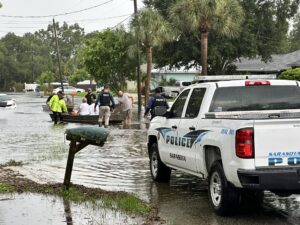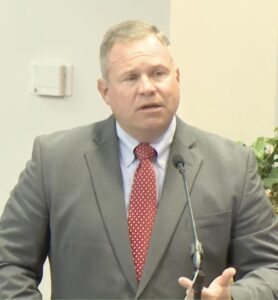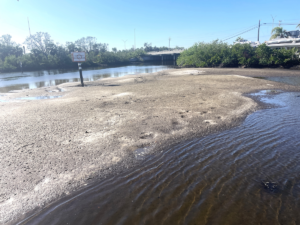The Public Works director argues new development has strained county resources.
By Ramon Lopez
Original Air Date: April 2, 2025
Host: After 27 years, Sarasota County wants to return stormwater management within city limits back to the city of Sarasota. Ramon Lopez first reported the plan last week, and now he is back to explain what’s behind this move and some of the implications.

SPD officers assist residents in flooded Pinebrook near Phillippi Creek. Photo via Sarasota Police Department on Facebook.
Ramon Lopez: The Board of Sarasota County Commissioners and the City of Sarasota Commission held a joint meeting late last week to discuss the area’s severe stormwater problem.
A so-called interlocal agreement currently provides for consolidated stormwater management between the city and county. The pact lays out responsibility for capital improvements to the stormwater system, such as repairs.
But the county stormwater brass is recommending termination of the interlocal agreement. They want to turn over responsibility of stormwater management within the city of Sarasota to the city.
They provided some options for the county and city commissioners to mull over. Setting a hard termination date for the stormwater agreement was discussed, as well as a three-year phased transition of stormwater responsibility.
However, Spencer Anderson, Sarasota County’s public works director, was short on details, producing more questions than answers on how stormwater management will change.
But before he outlined the major move on stormwater, he noted that the county held two stormwater workshops in January and March and a third is in the works.

Spencer Anderson.
Spencer Anderson: The overall review of the stormwater infrastructure is something that will be in a subsequent workshop where we talk more specifically about maintenance activities, and that is our primary focus right now throughout the stormwater infrastructure of the city and the county: making sure that we are prepared for this coming hurricane season.
RL: And he said last year’s trio of devastating hurricanes was more than the county could handle.
SA: Those storms were exceeding the level of service that we provide as a county. The rainfall that we experienced during those events was well beyond the 10 inches in 24 hours that is the county’s adopted level of service.
RL: But I digress. Anderson told the two sets of commissioners that his staff has reviewed the interlocal agreement on stormwater adopted in 1998 and believes it should be rescinded.
Why exactly? Anderson said things have moved on. He said the county has changed the emphasis from water quantity—that is, flood control—to water quality.
And previously, the county’s stormwater service area was 216 square miles, including 25 square miles of the City of Sarasota, or 12 percent of the overall service area.

The sandbar at the north fork of Phillippi Creek, flooded in the aftermath of Debby. Photo by Jim McWhorter via Sarasota News Leader.
But construction of new housing county-wide has expanded the coverage area by 87 square miles, a 40 percent increase—too much work for the county to handle alone.
SA: It does make sense for the county to suggest that we move away from providing services in the city and, through some mechanism, suggest that we terminate the interlocal agreement and help the city take on those services with city resources.
RL: City Commissioner Jen Ahearn-Koch said she was concerned about the proposal.
Jen Ahearn-Koch: I have many, many questions, as you can imagine. When I look at this and I think about the city taking on this responsibility, I imagine it’s quite large in dollars and also staff; in necessary facilities.
RL: Stormwater expert Steve Suau, who was asked by Anderson to do an independent study to determine the cause of the unprecedented flooding from Hurricane Debby, said a quick fix is not enough.
Steve Suau: Debby was pretty devastating along with the hurricanes we had last year—made it a very unique and wet year. But I point out that we’ve had these types of floods before and we’ll probably have them again. The real key—I tell this to policymakers and staff—is that they need to make sure that every policy, every strategy, every investment they make has the objective of reducing flood damage claims.
RL: Meanwhile, the local Climate Adaptation Center predicts 17 named storms, 10 hurricanes and five major hurricanes for the extremely active 2025 hurricane season. That prediction is in line with another from Accuweather. The Climate Adaptation Center has been especially accurate with its predictions.
This is Ramon Lopez for WSLR News.
WSLR News aims to keep the local community informed with our 1/2 hour local news show, quarterly newspaper and social media feeds. The local news broadcast airs on Wednesdays and Fridays at 6pm.